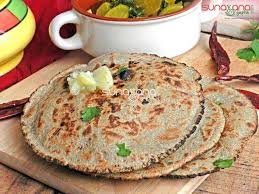A Traditional Indian Flatbread with Soul
There’s something incredibly grounding about making Bajre ki Roti—a wholesome, earthy flatbread made from pearl millet flour. You don’t need any fancy ingredients or equipment. Just your hands, a hot tawa, and a little bit of patience.
This roti is old-world. It’s the kind of food that villages in Rajasthan, Gujarat, Haryana, and Punjab have cherished for generations. It doesn’t have a luxurious origin story or exotic appeal. Instead, it’s rooted in survival, simplicity, and nourishment.
When I make bajre ki roti, I think of my grandmother. She never needed measuring cups or rolling pins. She’d just scoop up some bajra flour into a parat, pour in warm water, and gently press the dough into perfect circles using nothing but her palms. She served it hot off the tawa with white butter and jaggery—or sometimes spicy garlic chutney. That was lunch. That was comfort. That was enough.
So, if you’re ready to slow down, get your hands messy, and try a soulful Indian recipe that’s healthy, gluten-free, and deeply satisfying, let’s make Bajre ki Roti together.
Ingredients – Just a Few, But Powerful
You only need a handful of ingredients for bajre ki roti. The beauty of this dish is its simplicity.
For the dough:
- 2 cups bajra (pearl millet) flour
- Warm water, as needed (about ¾ to 1 cup)
- A pinch of salt (optional)
For serving (choose your favorites):
- Ghee (a must!)
- White butter (makhan)
- Jaggery (gur)
- Lehsun chutney (garlic chutney)
- Green chilies, pickles, or curd
Note: If you’re new to making this, keep 1–2 tablespoons of wheat flour handy. Adding just a bit can make shaping easier.
Step-by-Step Guide – Let’s Cook Together
Step 1: Making the Dough
Making the dough might feel a little different if you’ve only ever worked with wheat flour. Bajra is gluten-free, which means it doesn’t have the same elasticity. But don’t worry—it comes together beautifully with a little care.
In a wide bowl or parat:
- Add 2 cups of bajra flour and a pinch of salt.
- Begin pouring warm water slowly into the flour.
- Use your hand to mix and knead as you go. You’ll notice the dough is crumbly at first. That’s normal.
Keep working the flour patiently. It will take shape.
Knead with care:
- Don’t dump in all the water at once. Bajra flour absorbs water gradually.
- Keep pressing the flour together and kneading until it becomes a soft, pliable dough. It shouldn’t be sticky.
- If it feels too dry, dip your fingers in water and knead again.
- Cover the dough with a damp cloth and let it rest for 10–15 minutes.
This resting time makes a big difference. The dough becomes smoother and easier to handle.
Step 2: Shaping the Roti
Here’s where it gets fun—and a bit tricky if it’s your first time.
Because there’s no gluten in bajra flour, you can’t roll these rotis like you would with wheat flour. But you don’t need a rolling pin! Just your hands and some gentle pressing.
Patting method:
- Take a small ball of dough (about the size of a lemon).
- Place it between your palms and gently flatten.
- Sprinkle some dry bajra flour on a clean surface or parchment paper.
- Use your fingers or palms to press the dough into a round shape—about 5–6 inches in diameter.
It doesn’t have to be a perfect circle. Rustic shapes are welcome here!
Optional beginner tip:
- If the dough cracks or breaks, don’t worry. Patch it up with wet fingers.
- If it’s too tough to handle, mix in 1–2 tablespoons of wheat flour next time. It helps beginners shape it more easily while still keeping the essence of bajra.
Step 3: Cooking the Roti
This is where the aroma kicks in. Bajre ki roti has a distinct nutty, warm smell when it hits the hot tawa. Pure nostalgia.
Heat a tawa or skillet:
- Place it on medium heat. Let it get nice and hot before placing your roti.
- Carefully lift the roti (you can use a spatula or flip it with your palm and parchment paper).
Cook it gently:
- Place the roti on the tawa.
- Let it cook for 30–40 seconds or until you see small bubbles forming.
- Flip it carefully. Press the edges lightly with a cloth or spatula to help it puff slightly.
- Flip again. Repeat until both sides are cooked with brown spots.
Finish with ghee:
- Once done, remove the roti and immediately brush with ghee or place a dollop of white butter on top.
Serve hot. Bajre ki roti is best enjoyed fresh off the stove, warm and soft.
What to Serve With Bajre ki Roti?
This humble roti pairs beautifully with a variety of side dishes. Here are a few traditional and modern ideas:
Classic Indian Pairings:
- Lehsun Chutney: Spicy garlic chutney made with red chilies, garlic, and mustard oil.
- Sarson ka Saag: A winter favorite. The roti and saag duo is legendary in North India.
- Baingan Bharta: Smoky mashed eggplant with spices and mustard oil.
- Kadhi: Tangy yogurt-based curry with pakoras.
- Jaggery + White Butter: Sweet and rich—perfect for breakfast or a light dinner.
Healthier Combos:
- With curd and green chutney.
- With moong dal or masoor dal.
- With a side of seasoned stir-fried veggies.
Tips, Tricks & Troubleshooting
- Too dry to knead? Add warm water in small splashes while kneading.
- Cracking while shaping? Dip your hands in water and smooth the cracks gently.
- Roti not puffing? That’s okay. Bajra rotis rarely puff like wheat rotis. Just make sure both sides are cooked well.
- Add seeds! For a flavor boost, mix some cumin, sesame, or nigella seeds into the dough.
Health Benefits of Bajre ki Roti
Besides being delicious and filling, bajra (pearl millet) comes with a host of health benefits:
- Gluten-free: Great for people with gluten sensitivity or celiac disease.
- Rich in fiber: Aids digestion and keeps you fuller longer.
- High in iron & magnesium: Supports heart health and energy levels.
- Lowers cholesterol: Thanks to its insoluble fiber content.
- Good for diabetics: Has a low glycemic index.
A Slice of Rural India
When you make Bajre ki Roti, you’re not just cooking—you’re connecting with centuries of tradition. This is the kind of food that farmers ate before heading to the fields, that families in mud homes shared sitting cross-legged on the floor, that traveled across generations without ever being written in a cookbook.
It’s not supposed to be perfect. It’s supposed to be real.
So the next time you want to nourish yourself—not just your hunger, but your soul too—make bajre ki roti. Eat it hot, tear it with your hands, scoop up some garlic chutney or white butter, and enjoy every bite.
Because sometimes, food isn’t about complexity. Sometimes, it’s about grounding yourself to the earth—one roti at a time.

